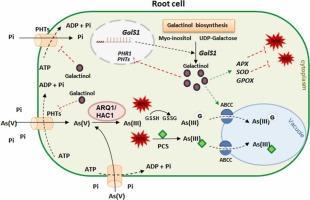半乳糖醇合成酶1 (AtGolS1)通过调节敏感生态型slai -1的磷酸盐稳态影响拟南芥对砷酸盐的耐受性
IF 11.3
1区 环境科学与生态学
Q1 ENGINEERING, ENVIRONMENTAL
引用次数: 0
摘要
砷酸盐[As(V)]是重金属砷(As)的无机形式,严重影响植物的生长和整体发育。As(V)在结构上类似于磷酸盐(Pi),其摄取是通过根中质膜定位的Pi转运蛋白介导的。在pi缺乏的条件下,As(V)的摄取增强,并在细胞水平上引起严重的氧化损伤。棉子糖家族寡糖(RFOs),包括半乳糖醇,在as (V)胁迫条件下具有渗透保护剂的功能,但其确切作用尚不清楚。本研究表明,由半乳糖醇合成酶基因AtGolS1编码的RFO生物合成途径的限速酶调节拟南芥的As(V)胁迫耐受性。在As(V)和Low Phosphate (Pi)+As(V)胁迫下,耐As(V)生态型Col-0和敏感型slai -1的AtGolS1表达显著升高。在Slavi-1背景下过表达AtGolS1的转基因株系在As(V)胁迫下表现出根系和茎部生长加快、活性氧(ROS)积累减少、半乳糖醇水平升高的特点。分子分析表明,AtGolS1OX细胞系下调高亲和Pi转运蛋白(PHT1;1, PHT1;4)和PHO1和PHF1等调节因子,可能限制通过Pi转运途径摄取as (V)。在As(V)胁迫下,atgols10ox系积累的Pi和As均少于Slavi-1系。解毒基因AtABCC1和AtABCC2在atgols10ox细胞系中的表达强于在slai -1细胞系中的表达,表明AtABCC1和AtABCC2在液泡中对砷的固存能力有所提高。在Slavi-1 AtGolS1中,单个氨基酸的替换没有改变其催化结构域,这意味着转录调节是关键的差异。这些结果表明,AtGolS1是连接半乳糖醇代谢与Pi转运蛋白调节的关键节点,从而减轻拟南芥中的as (V)毒性。本文章由计算机程序翻译,如有差异,请以英文原文为准。

Galactinol synthase 1, AtGolS1, affects arsenate tolerance by modulating phosphate homeostasis in sensitive ecotype Slavi-1 of Arabidopsis
Arsenate [As(V)], an inorganic form of heavy metal Arsenic (As), severely affects plant growth and overall development. As(V) is structurally analogous to Phosphate (Pi) and its uptake is mediated through the plasma membrane localised Pi transporters in the root. As(V) uptake is enhanced in Pi-deficient conditions and causes severe oxidative damage at the cellular level. The Raffinose Family Oligosaccharides (RFOs), including galactinol, function as osmoprotectants in plants in As(V) stress conditions, yet their precise role remains unclear. This study demonstrates that the rate-limiting enzyme of the RFO biosynthesis pathway, encoded by AtGolS1, a galactinol synthase gene, modulates As(V) stress tolerance in Arabidopsis. Comparative analyses between As(V)-tolerant ecotype Col-0 and sensitive Slavi-1 revealed significantly higher AtGolS1 expression in Col-0 under As(V) and Low Phosphate (Pi)+As(V) stress. Transgenic lines overexpressing AtGolS1 in the Slavi-1 background exhibited enhanced root and shoot growth and reduced reactive oxygen species (ROS) accumulation under As(V) stress, accompanied by elevated galactinol levels. Molecular analyses showed that AtGolS1OX lines downregulated high-affinity Pi transporters (PHT1;1, PHT1;4) and regulators such as PHO1 and PHF1, likely restricting As(V) uptake via Pi transport pathways. Under As(V) stress, AtGolS1OX lines accumulated less Pi and As than Slavi-1. Detoxification genes AtABCC1 and AtABCC2 were more strongly expressed in AtGolS1OX lines than in Slavi-1, suggesting improved vacuolar sequestration of As. A single amino acid substitution in Slavi-1 AtGolS1 did not alter its catalytic domain, implicating transcriptional regulation as the key difference. These results identify AtGolS1 as a critical node linking galactinol metabolism to Pi transporter regulation, thereby mitigating As(V) toxicity in Arabidopsis.
求助全文
通过发布文献求助,成功后即可免费获取论文全文。
去求助
来源期刊

Journal of Hazardous Materials
工程技术-工程:环境
CiteScore
25.40
自引率
5.90%
发文量
3059
审稿时长
58 days
期刊介绍:
The Journal of Hazardous Materials serves as a global platform for promoting cutting-edge research in the field of Environmental Science and Engineering. Our publication features a wide range of articles, including full-length research papers, review articles, and perspectives, with the aim of enhancing our understanding of the dangers and risks associated with various materials concerning public health and the environment. It is important to note that the term "environmental contaminants" refers specifically to substances that pose hazardous effects through contamination, while excluding those that do not have such impacts on the environment or human health. Moreover, we emphasize the distinction between wastes and hazardous materials in order to provide further clarity on the scope of the journal. We have a keen interest in exploring specific compounds and microbial agents that have adverse effects on the environment.
 求助内容:
求助内容: 应助结果提醒方式:
应助结果提醒方式:


